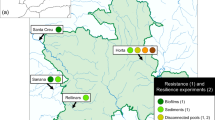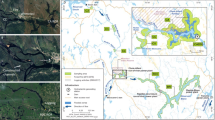Abstract
Epilithic community metabolism was determined on a seasonal basis over two years in nonregulated and regulated reaches of the Clearwater River in northern Idaho, U.S.A. Metabolism was estimated using three, 12-liter recirculating chambers and the dissolved oxygen method, with parameters expressed as g O2 m−2 d−1. In the nonregulated reach above the reservoir, gross community productivity (GCP) ranged from 0.8 to 3.2, community respiration (CR24) from 0.3 to 1.2, and production/respiration (P/R) ratios from 1.2 to 3.3. Epilithic metabolism in the regulated reach immediately below the dam increased sharply; GCP ranged from 4.2 to 25.5, CR24 from 1.9 to 9.7, and P/R ratios from 1.4 to 5.7. Increased primary production and respiration in the regulated reach was a result of extensive growth of an aquatic moss (Fontanalis neo-mexicanus). The influence of the dam on epilithic community metabolism was mitigated 2.5 km downstream of the dam due to the regulated North Fork of the Clearwater River (NFCR) merging with the larger, nonregulated Clearwater River. While the regulated Clearwater River below the confluence was somewhat affected by the regulated NFCR flows upstream, metabolism was similar to that found above the reservoir (GCP = 1.2 – 2.6, CR24 = 0.6 – 1.3, and P/R = 1.4 – 2.2). This study demonstrates that while Dworshak Dam has altered both primary production and respiration directly below the dam, the placement of the dam only 2.5 km upstream from a nonregulated reach greatly mitigates its effects on stream metabolism downstream. %
Similar content being viewed by others
References
American Public Health Association (APHA), 1975. Standard Methods for the Examination ofWater and Wastewater. 14th edn. American Public Health Association, Washington D.C.: 1268 pp.
Arscott, D. B., W. B. Bowden & J. C. Finlay, 1998. Comparison of epilithic algal and byrophyte metabolism in an artic tundra stream, Alaska. J. N. Am. Benthol. Soc. 17: 210–227.
Blinn, D. W., J. P. Shannon, P. L. Benenati & K. P. Wilson, 1998. Algal ecology in tailwater stream communities: the Colorado River below Glen Canyon Dam, Arizona. J. Phycol. 34: 734–740.
Bott, T. L., J. T. Brock, C. E. Cushing, S. V. Gregory, D. King & R. C. Petersen, 1978. A comparison of methods for measuring primary productivity and community respiration in streams. Hydrobiologia 60: 3–12.
Bott, L., J. T. Brock, C. S. Dunn, R. J. Naiman, R.W. Ovink & R. C. Petersen, 1985. Benthic community metabolism in four temperate stream systems: an inter-biome comparison and evaluation of the river continuum concept. Hydrobiologia 123: 3–45.
Fellows, C. S., H. Maurice Valett & C. N. Dahm, 2001. Wholestream metabolism in two montane streams: contributions of the hyporheic zone. Limnol. Oceanogr. 46: 523–531.
Findlay, S., D. Strayer, C. Goumbala & K. Gould, 1993. Metabolism of streamwater dissolved organic carbon in the shallow hyporheic zone. Limnol. Oceanogr. 38: 1493–1499.
Finlay, J. C. & W. B. Bowden, 1994. Controls on production of bryophytes in an arctic tundra stream. Freshwat. Biol. 32: 455–466.
Grimm, N. B. & S. G. Fisher, 1984. Exchange between interstitial and surface water: implications for stream metabolism and nutrient cycling. Hydrobiologia 111: 219–228.
Hall, C. A. S., 1972. Migration and metabolism in a temperate stream ecosystem. Ecology 53: 585–604.
Haslam, S. M., 1978. River Plants. Cambridge University Press. London, England.
Marzolf, E. R., P. L. Mulholland & A. D. Steinman, 1994. Improvements to the diurnal upstream-downstream dissolved oxygen change technique for determining whole-stream metabolism in small streams. Can. J. Fish. aquat. Sci. 51: 1591–1599.
McIntire, C. D. & H. K. Phinney, 1965. Laboratory studies of periphyton production and community metabolism in lotic environments. Ecol. Monogr. 35: 237–258.
McIntire, C. D., 1973. Periphyton dynamics in laboratory streams: A simulation model and its implications. Ecol. Monogr. 43: 399–420.
Minshall, G. W., 1978. Autotrophy in stream ecosystems. BioScience 28: 767–771.
Munn, M. D. & M. A. Brusven, 1991. Benthic macroinvertebrate communities in nonregulated and regulated waters of the Clearwater River, Idaho, U.S.A. Regul. Riv. Res. Manage. 6:1–11.
Naiman, R. J. & J. R. Sedell, 1980. Relationships between metabolic parameters and stream order in Oregon. Can. J. Fish. aquat. Sci. 37: 834–847.
Petts, G. S., 1984. Impounded Rivers: Perspectives for Ecological Management. John Wiley and Sons, New York: 326 pp.
Pfeifer, R. F. & W. F. McDiffett, 1975. Some factors affecting primary productivity of stream riffle communities. Arch. Hydrobiol. 75: 306–317.
Sokal, R. R. & F. J. Rohlf, 1995. Biometry. 3rd edn. W.H. Freeman and Company, New York: 887 pp.
Stanford, J. A. & J. V. Ward, 2001. Revisiting the serial discontinuity concept. Regul. Riv. Res. Manage. 17: 303–310.
Suren, A. M. & M. J. Winterbourne, 1992. The influence of periphyton, detritus and shelter on invertebrate colonization of aquatic bryophytes. Freshwat. Biol. 27: 327–339.
Usher, H. D. & D. W. Blinn, 1990. Influence of various exposure periods on the biomass and chlorophyll a of Cladophora glomerata (Chlorophyta). J. Phycol. 244-249.
Vannote, R. L., G. W. Minshall, K. W. Cummins, J. R. Sedell & C. E. Cushing, 1980. The river continuum concept. Can. J. Fish. aquat. Sci. 37: 130–137.
Vinson, M., 2001, Long-term dynamics of an invertebrate assemblage downstream from a large dam. Ecol. Appl. 11: 711–730.
Ward, J. F. & W. R. Meehan, 1984. Inexpensive digital daylight integrater. Progressive Fish Culturist 46.
Ward, J. V. & J. A. Stanford, 1983. Dynamics of Lotic Ecosystems. Ann Arbor Science Publishers, Ann Arbor, Michigan: 29–42.
Author information
Authors and Affiliations
Rights and permissions
About this article
Cite this article
Munn, M.D., Brusven, M.A. The influence of Dworshak Dam on epilithic community metabolism in the Clearwater River, U.S.A.. Hydrobiologia 513, 121–127 (2004). https://doi.org/10.1023/B:hydr.0000018177.78841.08
Issue Date:
DOI: https://doi.org/10.1023/B:hydr.0000018177.78841.08




